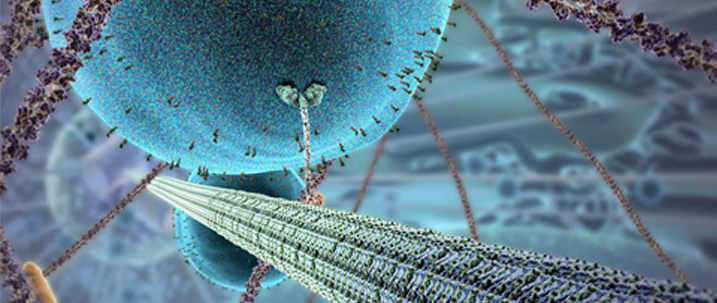Scope and aims

Transport of macromolecules, organelles and vesicles in living cells is a very complicated process that essentially determines and controls many biochemical reactions, growth and functioning of cells. The passive thermal diffusion through the overcrowded cytoplasm is combined with the active transport by motor proteins attached to microtubules. This intricate mechanism results in anomalous diffusions that found abundant experimental evidences but no consensus on the physical mechanism and the appropriate mathematical model is achieved so far. Single-particle tracking (SPT) experiments (video-tracking, optical tweezers, etc.) survey random trajectories of individual tracers inside living cells and can thus provide the missing information on the molecular transport in order to discriminate between different physical mechanisms (e.g., “caging” in the overcrowded cellular environment, visco-elastic properties of the cytoskeleton, hierarchical geometrical structure of the cytoplasm and/or nucleus, etc.) and to identify the appropriate theoretical model of anomalous diffusion (e.g., continuous-time random walks, generalized Langevin equation, diffusion on fractals, etc.). In SPT, an ensemble average of the quantities of interest (e.g., diffusivity, viscosity, first passage times, etc.) is often unavailable or even undesired, as tracers move in spatially heterogeneous and time evolving media such as living cells. One faces therefore a challenging problem of inferring dynamical, structural and functional properties of living cells from a limited (small) number of individual random realizations of an unknown stochastic process. The project aims at gathering physical, biological and statistical expertise to build a reliable inference procedure for the analysis of SPT experiments. The project will be developed in several complementary directions:
- A systematic comparison between recently developed inference tools (maximal excursion method, first passage time statistics, local mean-square displacement analysis, Bayesian methods, p-variation tests, etc.) on a common set of simulated/experimental trajectories. Such a systematic study will reveal the limitations/drawbacks of these separate methods, their sensitivity to different diffusion mechanisms and their robustness against variable experimental conditions.
- A theoretical and numerical study of the probabilistic properties of the inferred quantities (such as, e.g., the time-averaged mean-square displacement) for various kinds of anomalous diffusions. The knowledge of their probability distributions will allow for accurate statistical estimations and reliable interpretation of experimental data, with a potential disentanglement of statistical and biological sources of dispersion in measured quantities.
- Accounting for experimental “imperfections” (measurement noises, static localization uncertainty, blurring of a particle’s position over camera integration times, presence of a laser trapping potential, etc.) of video-tracking and optical tweezers acquisition, which were mainly ignored so far in theoretical models and inference tools.
Bringing these complementary fields together, we aim at establishing a synergetic inference protocol in which various statistical tools are combined, while their sensitivity and robustness are improved through the knowledge of the probability distributions of the inferred quantities and by accounting for experimental “imperfections”. This protocol will be released as a numerical library to assist experimentalists and biologists in statistical analysis of their data. A reliable biophysical and statistical analysis of SPT experiments will result in further understanding of the physical mechanisms and better mathematical modeling of the cellular transport, with potential bio-medical applications to controlling viral infections and efficient drug delivery in medical treatments.
Financing
This project is funded by the French National Research Agency
(Agence Nationale de la Recherche, ANR),
the grant ANR-13-JSV5-0006-01, from 15/03/2014 till 15/03/2018.
http://www.agence-nationale-recherche.fr/?Projet=ANR-13-JSV5-0006
